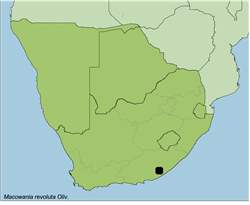Names and synonyms
Macowania revoluta Oliver
Type
MacOwan 2013, Cape, British Kaffraria, Mts of the Buffalo River, 670 m, Sept. (BOL, K, NBG, NH).
Derivation of names
Macowania = after Dr. Peter MacOwan (1830-1901), botanist, director of the Cape Town Botanic Gardens, and discoverer of new species at the Cape.
revoluta = with margins rolled backwards, downwards or outwards
Diagnostic characters
Capitula in terminal corymb
Capitula urn-shaped
Leaves reflexed on older stems
Involucral bract margins purplish
Description
Erect shrub to c. 1-5 m. Stems glandular-hispid, densely leafy when young, much branched terminally to form a corymb. Leaves not imbricated, initially spreading but reflexed on older branches, linear-lanceolate, very acute, up to 30 x 3 mm, broadest at the base, margins revolute, thinly woolly below, glandular-hispid above and on the midrib below. Capitula urn-shaped, 7-10 mm diam., solitary on branch tips, on short pedicels, pedicels white-woolly and covered in slender glands. Involucre bell-shaped, 12-14 mm long and as broad. Involucral bracts margined dark brown, glandular-hispid on the backs. Ray florets yellow, female and fertile. Disc florets yellow, functionally male, corolla narrowly cylindrical and hairy below, abruptly bell-shaped and glabrous above. Pappus setae half as long as tube of disc, soon caducous. Ovary of ray 15-ribbed, 2-3 mm long, pubescence sparse short and spreading; of disc 10-ribbed. Cypsela narrowly barrel-shaped, closely ribbed, glabrous or nearly so.
Flowering time
Mainly from September to November but also in April and May.
Distribution
Endemic in the Eastern Cape, being known only from forest margins on Pirie Mt and the neighbouring mountains about the sources of the Buffalo River, and nearby Hogsback and Wolf Ridge in the Amatola Mts, between about 650 and 1200 m above sea level.
Known from about 15 specimens.
Habitat
Mountain slopes and forest margins
Notes
Its closest ally is M. corymbosa from the KwaZulu-Natal Drakensberg. That species is readily distinguished by its linear, closely imbricated, leaves and crowded heads with sterile rays and fertile disc flowers.
In M. revoluta there are about 8 to 10 ray flowers and nearly all the cypselas are derived from these.
References
ANDERBERG, A.A. 1991. Taxonomy and phylogeny of the tribe Gnaphalieae (Asteraceae). Opera Botanica 104: 50-53.
GLEN, H.F. 2004. SAPPI, What's in a Name? The Meanings of the Botanical Names of Trees. Jacana.
HILLIARD, O.M. & BURTT, B.L. 1976. Notes on some plants of southern Africa chiefly from Natal: V. Notes from the Royal Botanic Garden Edinburgh 34,3: 260-276.
HILLIARD, O.M. 1977. Compositae in Natal. University of Natal Press.
KESTING, D. & CLARKE, H. 2008. Botanical names, what they mean. Wild Flowers of the Cape Peninsula, 3rd revised edition. Friends of Silvermine.
SMITH, C. A. 1927. The genus Macowania, Oliv. Bothalia 2:348-350.
